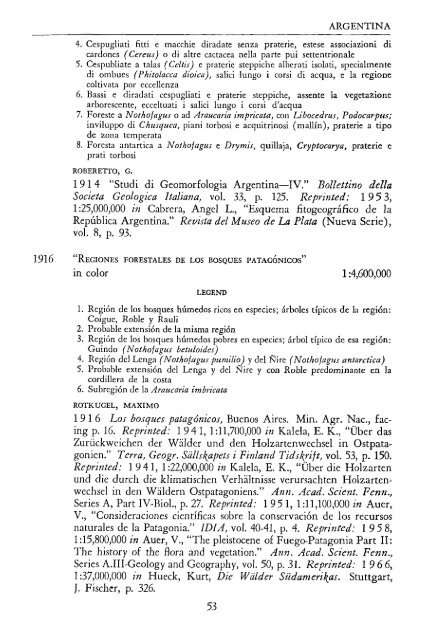international bibliography of vegetation maps - KU ScholarWorks ...
international bibliography of vegetation maps - KU ScholarWorks ...
international bibliography of vegetation maps - KU ScholarWorks ...
You also want an ePaper? Increase the reach of your titles
YUMPU automatically turns print PDFs into web optimized ePapers that Google loves.
ARGENTINA<br />
4. Cespugliati fitti e macchie diradate senza praterie, estese associazioni di<br />
cardones (Cereus) o di altre cactácea nella parte pui settentrionale<br />
5. Cespubliate a talas (Celtis) e praterie steppiche alberati isolati, specialmente<br />
di ombues (Phitolacca dioica), salici lungo i corsi di acqua, e la regione<br />
coltivata por eccellenza<br />
6. Bassi e diradati cespugliati e praterie steppiche, assente la vegetazione<br />
arborescente, ecceltuati i salici lungo i corsi d'aequa<br />
7. Foreste a Nothojagus o ad Araucaria impricata, con Libocedrus, Podocarpus;<br />
inviluppo di Chusquea, piani torbosi e acquitrinosi (mallín), praterie a tipo<br />
de zona temperata<br />
8. Foresta antartica a Nothojagus e Drymis, quillaja, Cryptocarya, praterie e<br />
prati torbosi<br />
ROBERETTO, G.<br />
1914 "Studi di Geomorfologia Argentina—IV." Bolleitino della<br />
Societa Geológica Italiana, vol. 33, p. 125. Reprinted: 19 5 3,<br />
1:25,000,000 in Cabrera, Angel L., "Esquema fkogeográfico de la<br />
República Argentina." Revista del Museo de La Plata (Nueva Serie),<br />
vol. 8, p. 93.<br />
1916 "REGIONES FORESTALES DE LOS BOSQUES PATAGÓNICOS"<br />
in color 1:4,600,000<br />
LEGEND<br />
1. Región de los bosques húmedos ricos en especies; árboles típicos de la región:<br />
Coigue, Roble y Rauli<br />
2. Probable extensión de la misma región<br />
3. Región de los bosques húmedos pobres en especies; árbol típico de esa región:<br />
Guindo (Nothojagus betuloides)<br />
4. Región del Lcnga (Nothojagus pumilio) y del Ñire (Nothojagus antárctica)<br />
5. Probable extensión del Lenga y del Ñire y con Roble predominante en la<br />
cordillera de la costa<br />
6. Subrcgión de la Araucaria imbricata<br />
ROT<strong>KU</strong>GEL,<br />
MAXIMO<br />
1916 Los bosques patagónicos, Buenos Aires. Min. Agr. Nac, facing<br />
p. 16. Reprinted: 1 941, 1:11,700,000 in Kalela, E. K., "Über das<br />
Zurückweichen der Wälder und den Holzartenwechsel in Ostpatagonien."<br />
Terra, Geogr. Sällskßpets i Finland Tidskrijt, vol. 53, p. 150.<br />
Reprinted: 1 9 41,1:22,000,000 in Kalela, E. K., "Über die Holzarten<br />
und die durch die klimatischen Verhältnisse verursachten Holzartenwechscl<br />
in den Wäldern Ostpatagoniens." Ann. Acad. Scient. Fenn.,<br />
Series A, Part IV-Biol., p. 27. Reprinted: 195 1, 1:11,100,000 in Auer,<br />
V., "Consideraciones científicas sobre la conservación de los recursos<br />
naturales de la Patagonia." IDIA, vol. 40-41, p. 4. Reprinted: 1 9 5 8,<br />
1:15,800,000 in Auer, V., "The pleistocene <strong>of</strong> Fuego-Patagonia Part II:<br />
The history <strong>of</strong> the flora and <strong>vegetation</strong>." Ann. Acad. Scient. Fenn.,<br />
Series A.III-Geology and Geography, vol. 50, p. 31. Reprinted: 1 966,<br />
1:37,000,000 in Hueck, Kurt, Die Wälder Südamerikas. Stuttgart,<br />
J. Fischer, p. 326.<br />
53
















